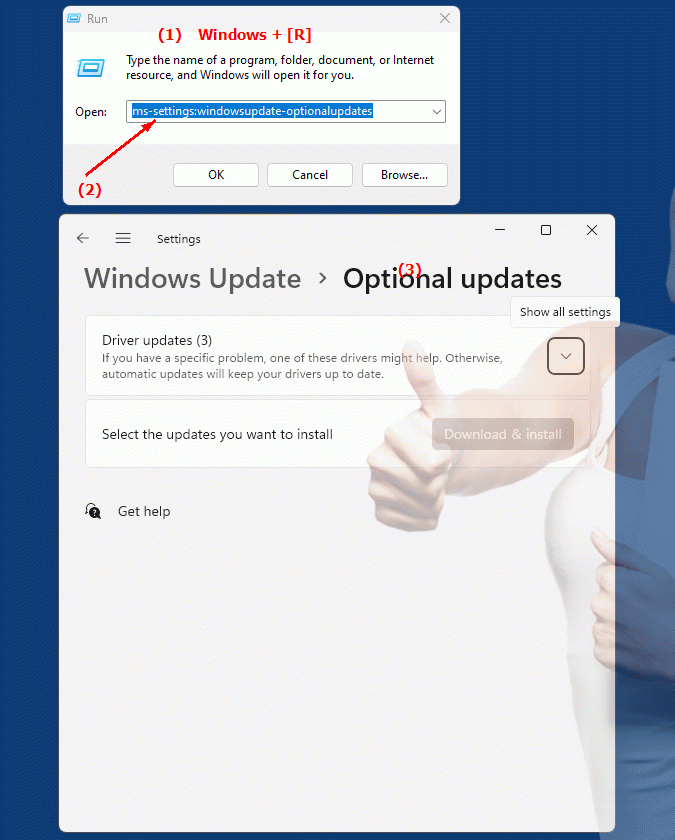The URI "ms-settings:windowsupdate-optionalupdates" opens the Optional Updates page in Windows 10 und 11 Settings.
This page allows users to manage optional updates for Windows and the installed drivers. Here is a detailed description of the availability, features, and relevant build numbers for Windows 10, 11, and 12:
1. ms-settings:windowsupdate-optionalupdates
2. Availability under Windows
3. Other useful commands in the Windows settings
1. The Command ms-settings:windowsupdate-optionalupdates
1. Activate the Run menu by pressing Windows R.2. Simply enter the command: ms-settings:windowsupdate-optionalupdates
(Use the command for a desktop shortcut as well.)
3. Press [Enter] or the OK button to execute the action.
(... see Image-1 Point 1 to 3)
The settings explained above are now available to you in Windows 10, 11 or 12.
This will address the following questions and challenges.

1b. This will address the following questions and challenges.
How can I manage optional updates for Windows and installed drivers in Windows Settings?Can you give step-by-step instructions on how to set up optional updates in Windows settings?
How can I customize the features and functionality of optional Windows updates to meet the needs of my organization?
How should one consider configuring optional updates for different user groups to ensure that all needs are covered?
2. Available in Windows 10, 11, 12 and the corresponding build numbers!
Availability by Windows version
1. Windows 10:
- Available from:
Windows 10 Version 1903 (Build 18362)
- Description Starting with version 1903 of Windows 10, the ms-settings:windowsupdate-optionalupdates URI was introduced to help users access optional updates. The Optional Updates page allows users to view updates that were not installed automatically, including:
- Optional Quality Updates:
Updates that contain additional features or improvements that are not classified as critical.
- Driver Updates:
Updates to hardware drivers that are optional but may provide improvements or bug fixes.
- Feature Updates:
Updates that contain major improvements or new features that are not strictly required.
2. Windows 11:
- Available from:
Windows 11 Version 21H2 (Build 22000)
- Description In Windows 11, the ms-settings:windowsupdate-optionalupdates URI is still available, with improvements in the UI and user experience. The Optional Updates page contains similar functionality to Windows 10, but with the following additional features:
- Optimized user interface:
Improved visual representation of optional updates, seamlessly integrated into the design of Windows 11.
- Extended update information:
More detailed information about the optional updates, including improvement notes and download sizes.
- Advanced Driver Management:
Improved capabilities for managing and installing driver updates.
3. Windows 12:
- Available from:
Windows 12 is expected to be released in 2024.
- Description:
In Windows 12, the ms-settings:windowsupdate-optionalupdates URI is expected to continue to be available, with further improvements and new features:
- Further user interface improvements:
Further adjustments and improvements to the presentation of optional updates.
- Advanced Update Management:
Improved optional and driver update management capabilities, including new filtering and sorting options.
- Integration of new update technologies:
Use of new technologies to more efficiently manage and install optional updates.
Description of the function
The URI "ms-settings:windowsupdate-optionalupdates" opens the Optional Updates page in Windows Settings. This page provides the following main features:
- View optional updates:
- Quality Updates:
Users can view optional quality updates that provide additional features or improvements but are not required for system stability or security.
- Driver Updates:
Displays available optional driver updates for the installed hardware. These updates may improve hardware performance or compatibility.
- Feature Updates:
If available, optional feature updates that provide major changes or new features will also be shown.
- Manage and install updates:
- Installing Updates:
Users can select and install optional updates if they choose. This gives users more control over keeping their systems and hardware updated.
- Download and Install:
The page allows users to download and install updates that are not automatically included in the regular Windows Update cycles.
- Update history and details:
- Update Details:
Users can view detailed information about the optional updates, including enhancement notes, version number, and download size.
- Update History:
The page can display a history of optional updates already installed to provide an overview of past installations.
Application
To get to the Optional Updates page, users can type the URI "ms-settings:windowsupdate-optionalupdates" in the address bar of the Windows Start menu or create a shortcut. This direct link provides quick access to optional updates that were not installed automatically and provides a user-friendly way to manage system and driver updates.
The Optional Updates page is particularly useful for users who want to install certain features or improvements that are not classified as critical updates. It provides a central place to manage these updates and gives users control over which updates are installed on their system.
